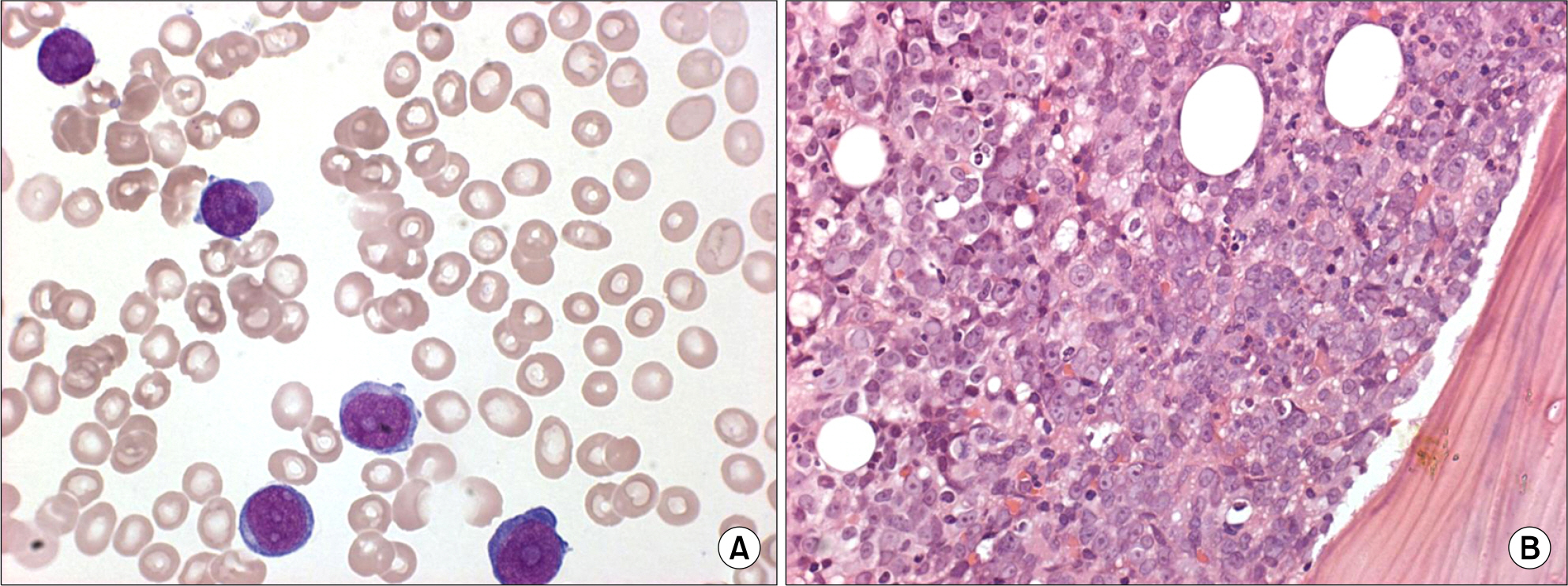Korean J Hematol.
2009 Dec;44(4):244-248. 10.5045/kjh.2009.44.4.244.
Long-term Complete Remission in a 71-year-old Patient with AML-M7 after Low-dose Cytarabine Induction and Intermediate-dose Cytarabine Consolidation Treatment
- Affiliations
-
- 1Department of Internal Medicine, Seoul National University College of Medicine, Seoul, Korea. jslee0918@gmail.com
- 2Department of Laboratory Medicine, Seoul National University College of Medicine, Seoul, Korea.
- KMID: 2252103
- DOI: http://doi.org/10.5045/kjh.2009.44.4.244
Abstract
- The authors describe the case of a 71-year-old patient with acute megakaryocytic leukemia (AML-M7) who was successfully treated with low-dose cytarabine induction followed by intermediate-dose cytarabine consolidation therapy. The patient presented with infection and rapidly increasing blood blasts. The diagnosis was consistent with AML-M7 with a normal karyotype. Peripheral blood blasts decreased rapidly upon low-dose cytarabine administration, and the patient achieved complete remission after two courses of low-dose cytarabine (10 mg/m2 bid for 12 days). Consolidation therapy with intermediate-dose cytarabine (1.0 g/m2 bid on day 1, 3 and 5) was then instituted without serious complication. He remained in complete remission at the time of writing 47 month after diagnosis. In spite of multiple poor prognostic factors, this patient showed excellent treatment outcome through low-dose cytarabine induction and intermediate- dose cytarabine consolidation. It needs to be validated whether acute leukemia with a megakaryocytic morphology is exceptionally sensitive to cytarabine.
Keyword
MeSH Terms
Figure
Reference
-
References
1. Kuendgen A, Germing U. Emerging treatment strategies for acute myeloid leukemia (AML) in the elderly. Cancer Treat Rev. 2009; 35:97–120.
Article2. Vey N, Coso D, Bardou VJ, et al. The benefit of induction chemotherapy in patients age > or= 75 years. Cancer. 2004; 101:325–31.3. Reiffers J, Huguet F, Stoppa AM, Michallet M, Hurteloup P. Intensive induction chemotherapy in elderly patients. The BGMT Group. Br J Haematol. 1992; 82:175–6.4. Löwenberg B, Suciu S, Archimbaud E, et al. Mitoxantrone versus daunorubicin in induction-consolidation chemotherapy–the value of low-dose cytarabine for maintenance of remission, and an assessment of prognostic factors in acute myeloid leukemia in the elderly: final report. European organization for the research and treatment of cancer and the dutch-belgian hemato-oncology cooperative hovon group. J Clin Oncol. 1998; 16:872–81.
Article5. Baudard M, Marie JP, Cadiou M, ViguiéF , Zittoun R. Acute myelogenous leukaemia in the elderly: retrospective study of 235 consecutive patients. Br J Haematol. 1994; 86:82–91.
Article6. Appelbaum FR, Gundacker H, Head DR, et al. Age and acute myeloid leukemia. Blood. 2006; 107:3481–5.
Article7. Kantarjian H, O'Brien S, Cortes J, et al. Results of intensive chemotherapy in 998 patients age 65 years or older with acute myeloid leukemia or high-risk myelodysplastic syndrome: predictive prognostic models for outcome. Cancer. 2006; 106:1090–8.8. Pagano L, Pulsoni A, Vignetti M, et al. Acute mega-karyoblastic leukemia: experience of GIMEMA trials. Leukemia. 2002; 16:1622–6.
Article9. Tallman MS, Neuberg D, Bennett JM, et al. Acute megakaryocytic leukemia: the eastern cooperative oncology group experience. Blood. 2000; 96:2405–11.10. Deschler B, de Witte T, Mertelsmann R, Lübbert M. Treatment decision-making for older patients with high-risk myelodysplastic syndrome or acute myeloid leukemia: problems and approaches. Haematologica. 2006; 91:1513–22.11. Burnett AK, Milligan D, Prentice AG, et al. A comparison of low-dose cytarabine and hydroxyurea with or without all-trans retinoic acid for acute myeloid leukemia and high-risk myelodysplastic syndrome in patients not considered fit for intensive treatment. Cancer. 2007; 109:1114–24.
Article12. Tilly H, Castaigne S, Bordessoule D, et al. Low-dose cytarabine versus intensive chemotherapy in the treatment of acute nonlymphocytic leukemia in the elderly. J Clin Oncol. 1990; 8:272–9.
Article13. Goldstone AH, Burnett AK, Wheatley K, Smith AG, Hutchinson RM, Clark RE. Attempts to improve treatment outcomes in acute myeloid leukemia (AML) in older patients: the results of the United Kingdom Medical Research Council AML11 trial. Blood. 2001; 98:1302–11.
Article14. Mayer RJ, Davis RB, Schiffer CA, et al. Intensive postremission chemotherapy in adults with acute myeloid leukemia. Cancer and Leukemia Group B. N Engl J Med. 1994; 331:896–903.15. Sperr WR, Piribauer M, Wimazal F, et al. A novel effective and safe consolidation for patients over 60 years with acute myeloid leukemia: intermediate dose cytarabine (2×1 g/m2 on days 1, 3, and 5). Clin Cancer Res. 2004; 10:3965–71.
- Full Text Links
- Actions
-
Cited
- CITED
-
- Close
- Share
- Similar articles
-
- Standard Induction Followed by Low Dose Cytarabine for the Treatment of Acute Myeloid Leukemia of Down Syndrome
- Prognostic Implications of Cytarabine Dose in Consolidation Chemotherapy for the Patients with Acute Myelogenous Leukemia
- Cytarabine and Idarubicin Induction Chemotherapy in Patients with Acute Myelogenous Leukemia
- Hematopoietic Stem Cell Transplantation in Elderly Patients with Acute Myeloid Leukemia
- A Case of Acute Myelogenous Leukemia during Pregnancy


